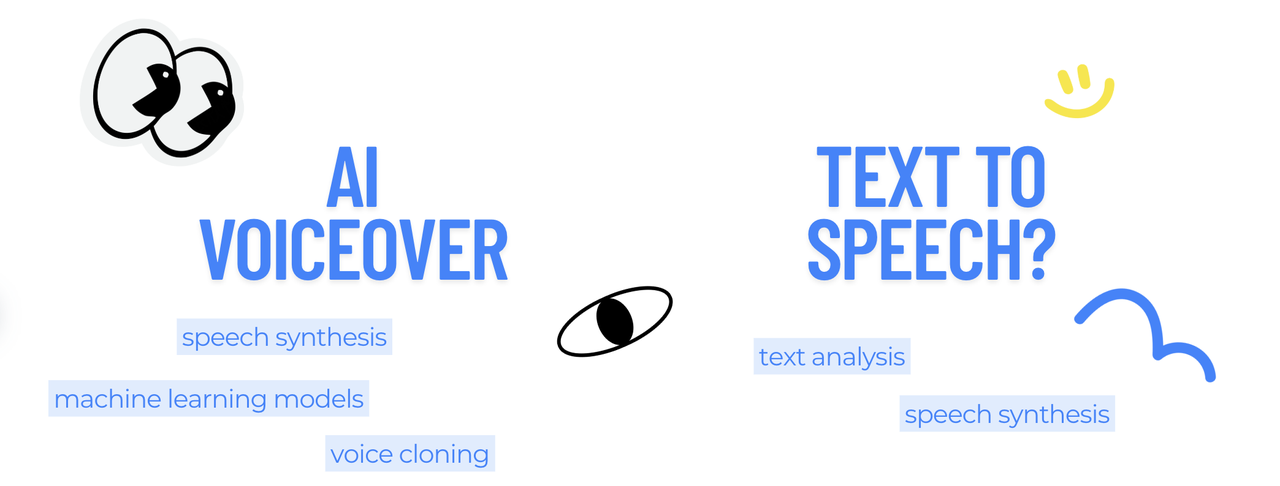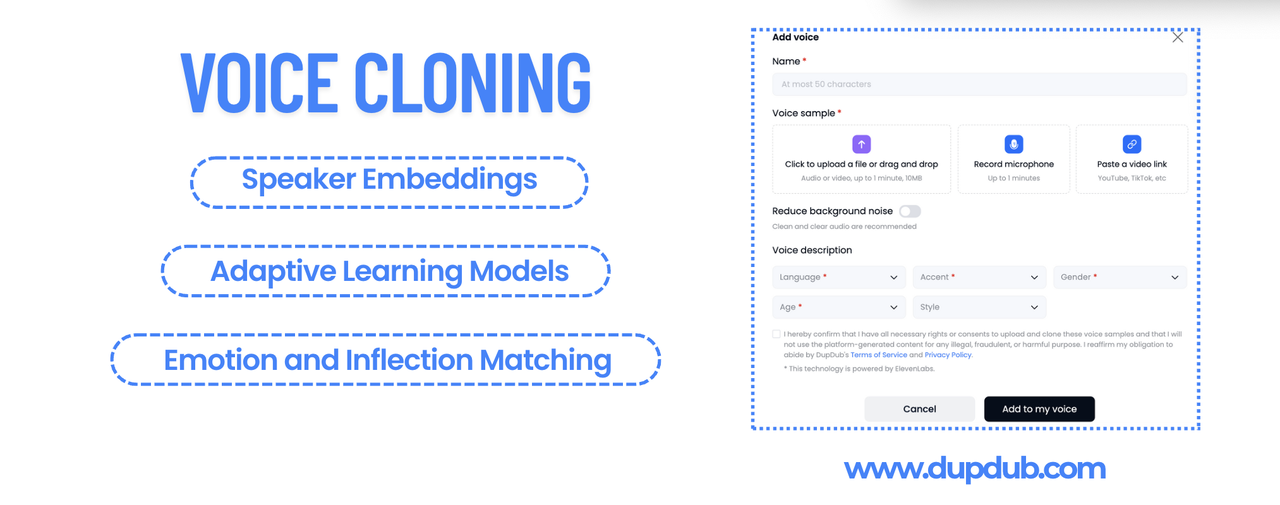Introduction
AI voiceover and text-to-speech (TTS) technology are changing how we create and listen to content. Whether you make YouTube videos, create podcasts, or need voiceovers for other projects, AI-generated voices offer a fast, affordable, and high-quality alternative to hiring voice actors. Thanks to improvements in speech synthesis and AI learning, these voices now sound more natural than ever, making them useful for many types of content creators.
In this guide, you’ll learn:

-
The key differences between AI voiceover and text-to-speech (TTS)
-
Why AI-generated voices are transforming content creation in 2025
-
How AI voice synthesis, voice cloning, and natural language processing (NLP) work
-
The ethical considerations and future trends in AI voice technology
With more people watching videos and listening to audio content, having high-quality voiceovers is more important than ever. AI voice generation allows creators to produce realistic, engaging voices without spending a lot of time or money on traditional recordings. This guide will explain everything you need to know about AI voiceover and TTS so you can make the best choices and improve your content.
Let’s get started.
What is AI Voiceover & Text to Speech?

AI voiceover and text-to-speech (TTS) are two technologies that convert text into spoken words using artificial intelligence. While they may seem similar, there are key differences between them.
-
AI Voiceover: This refers to AI-generated speech that sounds natural and expressive, often used for videos, podcasts, audiobooks, and advertisements. AI voiceovers aim to replicate human-like speech with realistic emotions, tone, and pacing.
-
Text to Speech (TTS): TTS technology converts written text into spoken words, but it is often more robotic and lacks emotional expression. TTS is commonly used in accessibility tools, virtual assistants, and automated announcements.
How AI Voiceover Works
AI voiceovers use advanced speech synthesis and machine learning models to analyze speech patterns and create natural-sounding voices. By training on real human recordings, AI can mimic different accents, emotions, and even specific voices through voice cloning.
How Text-to-Speech (TTS) Works
TTS systems use text analysis and speech synthesis to turn written words into audio. Unlike AI voiceovers, TTS is often used for functional purposes, such as reading text aloud for visually impaired users or enabling voice responses in chatbots.
Key Differences

| Feature | AI Voiceover | Text to Speech (TTS) |
| Sound Quality | Human-like, expressive | Often robotic, lacks emotion |
| Use Cases | Videos, podcasts, ads, audiobooks | Accessibility, virtual assistants, automation |
| Customization | Can mimic specific voices and emotions | Usually limited customization |
| Technology | Advanced AI models, deep learning | Basic speech synthesis algorithms |
With the rise of AI-generated voices, content creators can now use tools like DupDub to produce lifelike narrations in multiple languages, making voiceovers faster and more affordable than ever.

Why AI Voiceover & TTS Are Essential in 2025
The Rise of Video and Audio Content
The demand for high-quality voice content is increasing rapidly as platforms like YouTube, TikTok, and podcasts continue to grow. More businesses and individual creators are turning to AI-generated voices to scale their content production efficiently. Whether for marketing videos, e-learning modules, or corporate training, AI voiceover and text-to-speech (TTS) provide a fast and cost-effective solution.
Why AI Voice is Replacing Traditional Narration
Traditional voiceovers require hiring voice actors, booking studio time, and multiple rounds of editing. AI voiceover eliminates these challenges by providing:

-
Faster Turnaround – AI-generated voices can produce high-quality narration in minutes.
-
Lower Costs – No need to pay for expensive recording sessions or professional voice actors.
-
Scalability – AI voices can be generated in multiple languages instantly, allowing content creators to reach global audiences.
-
Customization – AI voiceovers can be fine-tuned for tone, style, and emotional expression, making them almost indistinguishable from human narration.
Industries Benefiting the Most from AI Voice Technology
AI voiceover and TTS are being adopted across various industries:

-
Marketing & Advertising – AI-generated voices are used in promotional videos, social media ads, and product explainers.
-
E-Learning & Education – Schools and online course creators use AI voices to generate engaging lesson narrations.
-
Audiobooks & Podcasts – AI allows authors and content creators to quickly generate narrated content without the need for professional voice actors.
-
Customer Service & Virtual Assistants – AI-driven voice responses enhance customer interactions through chatbots and automated phone systems.
The Competitive Advantage of AI Voice Technology
With AI voice synthesis improving rapidly, brands and creators who leverage AI voiceover and TTS will have a distinct competitive edge. DupDub, for example, allows businesses to generate high-quality voiceovers in multiple languages, helping them expand into international markets effortlessly.

AI-generated voice content is no longer a futuristic concept—it’s a must-have tool for content creators looking to stay ahead in 2025.
How AI Voice Synthesis Works
AI voice synthesis is powered by advanced artificial intelligence models that analyze human speech patterns and recreate them with incredible accuracy. By leveraging deep learning, natural language processing (NLP), and voice cloning technology, AI-generated voices can now mimic human-like intonation, rhythm, and emotional expression.
Speech Synthesis AI: How AI Learns to Mimic Human Speech
Modern AI voice synthesis models are trained using vast datasets of recorded human speech. These models analyze the way people naturally talk, including:

-
Pronunciation and phonetics – Ensuring AI-generated speech sounds natural and not robotic.
-
Rhythm and pacing – Adjusting pauses, stress, and emphasis for better flow.
-
Tone and emotion – Modulating voices to match different moods and contexts.
Technologies like WaveNet and Tacotron have significantly improved AI voice synthesis, making text-to-speech (TTS) systems sound more realistic than ever.
Voice Cloning: Can AI Replicate Any Voice?

One of the most impressive developments in AI voice synthesis is voice cloning. By analyzing just a few seconds of audio, AI can replicate a specific person’s voice with high accuracy. This is achieved through:
-
Speaker Embeddings – AI extracts unique vocal characteristics to recreate an individual’s voice.
-
Adaptive Learning Models – Continuous improvement based on additional voice data.
-
Emotion and Inflection Matching – Capturing nuances that make a voice sound more human.
DupDub is among the AI platforms enabling users to create voice clones for personal or commercial use, making it easier for content creators to scale their projects while maintaining a unique brand voice.
Natural Language Processing (NLP): How AI Understands Text

To produce high-quality AI-generated speech, NLP algorithms analyze the context, tone, and structure of written text. This ensures the AI voice sounds coherent and expressive, rather than mechanical.
-
Context Awareness – AI adapts pronunciation based on sentence meaning.
-
Emotion Recognition – Adjusts voice tone to reflect the sentiment of the text.
-
Multilingual Capabilities – Supports multiple languages and dialects with high accuracy.
By combining speech synthesis, voice cloning, and NLP, AI voiceover technology is now more powerful and accessible than ever. These advancements allow businesses, educators, and creators to produce high-quality voice content at scale.
The Future of AI Voice Technology
AI voice technology is improving quickly, and in the future, AI-generated voices will sound even more natural and be used in more ways. Here are some key trends that will shape AI voiceovers and text-to-speech (TTS) in the coming years.
-
AI Voice Cloning for Personal Use

One exciting development is AI voice cloning, which means AI can copy a person’s voice with just a short audio recording. This has many uses, such as:
-
Custom Voices for Companies – Businesses can create their own unique AI voices for branding.
-
Famous Voices in Media – AI can allow celebrities or influencers to have their voices used in digital content.
-
Helping People with Speech Disabilities – AI can create a digital version of a person’s voice for those who have trouble speaking.
-
Real-Time Voice Translation and Multiple Languages

AI voice technology is making it easier for people to communicate in different languages. New improvements include:
-
Instant Translation – AI can translate spoken words while keeping the speaker’s voice and tone.
-
Multilingual Voiceovers – Companies can use AI to produce voiceovers in multiple languages.
-
Better Dubbing for Videos – AI-generated voices can make foreign-language movies and shows more engaging.
-
Smarter AI Assistants and Interactive Voices

AI voices are also being used to make virtual assistants, chatbots, and video game characters more lifelike. Future improvements will include:
-
Understanding Emotions – AI will adjust its tone based on how people speak to it.
-
More Realistic Voices – AI-generated speech will sound even more like real people.
-
Interactive AI Avatars – AI-powered characters will become more common in customer service and online content.
-
Ethical Issues and Rules

As AI voice technology improves, there will be more discussions about how it should be used responsibly. Some key concerns include:
-
Fake Voices for Scams – Rules will need to be made to stop AI voice cloning from being used for fraud.
-
Privacy and Permission – Companies will have to be clear about how they collect and use voice data.
-
AI Labels for Content – Some governments may require AI-generated voices to be clearly labeled in media and ads.
-
AI Voice Platforms Leading the Way

Platforms like DupDub are pushing AI voice technology forward by offering high-quality voice synthesis, real-time translation, and customizable speech. Businesses and content creators who start using AI voice tools now will have an advantage in the future.
The future of AI voice technology isn’t just about making things automatic—it’s about creating realistic, engaging, and personalized audio experiences that change the way people create content and communicate across the world.
Final Thoughts
AI voiceover and text-to-speech (TTS) technology are no longer just ideas from the future—they are already changing how we create content, communicate, and access information. Whether you make videos, teach, or run a business, AI-generated voices offer a fast and affordable way to create high-quality audio.
Why AI Voice Technology Matters
AI voices sound more natural than ever and are being used in many industries. They help people create professional voiceovers without needing a real person to record them. As technology improves, AI voices are becoming even more advanced and useful.
Key Takeaways

-
AI voiceover vs. TTS – AI voiceovers sound more like real people and can be customized, while TTS is mainly for reading text aloud.
-
Benefits of AI voices – Faster content creation, lower costs, support for many languages, and easy scalability.
-
Future trends – Expect even more realistic AI voices, real-time translations, and improved interactive applications.
-
Ethical concerns – As AI voices improve, it’s important to use them responsibly and follow rules to prevent misuse.
Getting Started with AI Voice Technology
If you want to try AI-generated voices, platforms like DupDub offer tools for creating high-quality voiceovers, voice cloning, and multilingual narration. Businesses and creators who start using AI voice technology now will have an advantage as this technology continues to grow.
AI voice technology is here to stay, making content creation easier, faster, and more creative. As this field continues to evolve, staying informed about the latest advancements will help you make the most of AI-generated voices.


